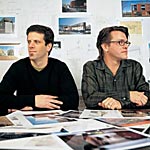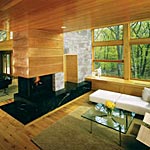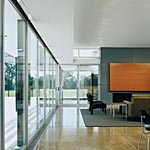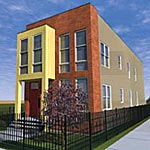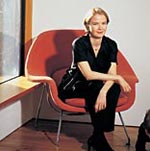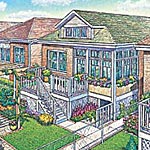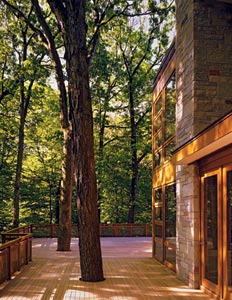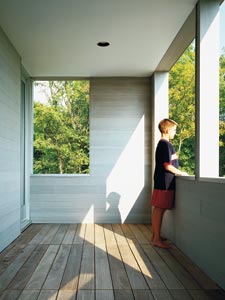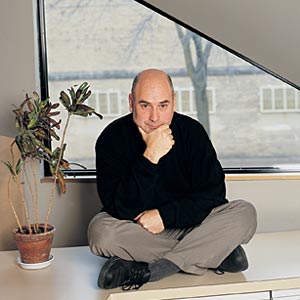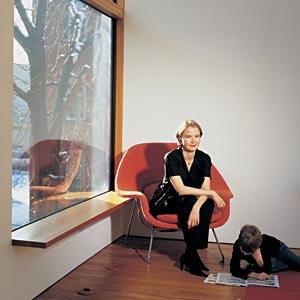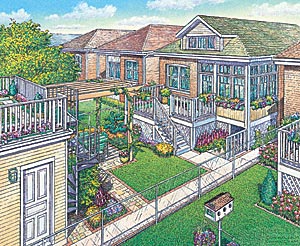Young couple with baby, one on the way, and vacant lot seek talented professional to make their housing dreams come true. Must have a modern aesthetic and be eco-friendly. Hiring an architect is a lot like looking for love. You want someone who understands your needs, your values, your budget, and your urgent desire for a meditation room. Or a green roof. Or a wine cellar. Each of these Chicago architects has a special expertise and might just be your true match. What do you want to do?
|
|
||
|
|
Space-Smart Urbanists
Stand out while fitting in
Richard Blender and Michael Wilkinson
Wilkinson Blender Architecture
Remember high school? You tried to fit in, and your Members Only jacket proved it. Now you know that fitting in isn’t about following trends and acquiring status symbols. Granite countertops and soaring great rooms aren’t for everybody. Your house should fit you, your family, and your community. For a good fit, go to Richard Blender and Michael Wilkinson.
Blender and Wilkinson say that many of their clients are turned off by generic edifices that dwarf the older structures around them. "There’s a large group whose needs are not being met," says Blender. Their clients want a modern urban house, an affordable alternative that uses space efficiently and fits on its lot with space left over to garden and play. "Small is the new big," Wilkinson reports.
If you hire Wilkinson Blender (http://www.wbarch.com/), their first question will be, "How do you want to live?" They spend time with clients defining space requirements for different activities, figuring out what spaces need to be near others, and delving into the nuances of family life.
Their houses have included such idiosyncratic elements as a backyard amphitheatre, a rooftop garden that incorporates solar panels and wind turbines, and a flexible dining room that can accommodate anywhere from five to 20 people. Very few of their houses include formal living rooms. "A house should have no spaces that you don’t use," says Blender. "A formal living room is often just a museum setup."
Their houses show respect for the fabric of neighborhoods by fitting in with the structures around them. Where appropriate, Wilkinson and Blender preserve original façades while modernizing the interiors and backs of buildings. They respect their own neighborhood, too. They both live in Roscoe Village, where their office is located, and have worked pro bono on projects for neighborhood parks and also on the gateway structure for the annual Retro on Roscoe street fair.
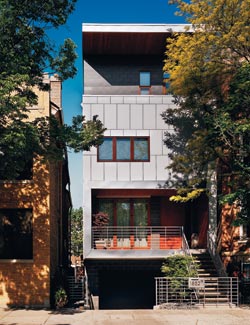 |
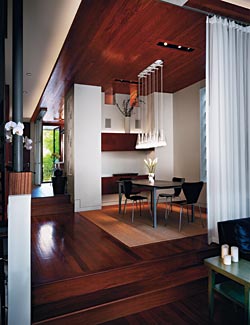 |
| Glass doors frame the view of a park across the street from this Old Town home. Inside, the kitchen steps down into the dining room, which steps down to a living room with 14-foot ceilings. A bridge connects the main level of the house with a landscaped garden. | |
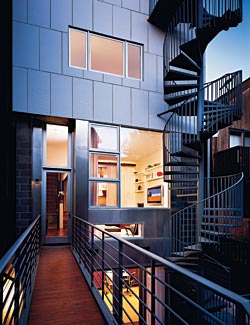
Photography: Padgett and Company
|
|
Prairie Specialist
Live in a home with the Wright attitude
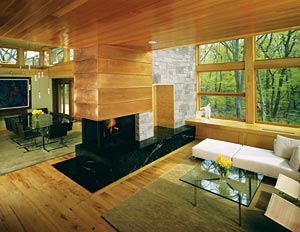 This Oak Brook home, owned by avid horticulturalists and located on a secluded three-acre lot, was designed to bring sensible Midwest design into a contemporary context. Wisconsin stone, copper, stained cedar, maple, and Douglas fir connect interior and exterior spaces. The home’s large windows, U-shaped floor plan, and sunny southern exposure make the most of natural light. |
|
|
John Eifler
Eifler & Associates Architects
If you own a house by Frank Lloyd Wright, or want to look as if you do, go to John Eifler (http://www.eiflerassociates.com/). The Wisconsin native has planned meticulous restorations and renovations of Prairie-style houses from Oak Park to Scottsdale, including Wright’s Wisconsin estate, Taliesin, and Taliesin West in Arizona.
While some of those houses are now museums, Eifler also enjoys reworking historical homes for today’s families. "I want to modernize them in a way that’s seamless, and make older homes be more what they are," he says. Most big rehabs seem to be inspired by the need to redo the kitchen, he adds. "Then the owners say, ‘While you’re at it …’ "
His intimate contact with great buildings of the past inspires his designs for new buildings. "It’s a constant education," he says.
Eifler is saddened that "Prairie style" has turned into a decorative motif like colonial or Tudor or gothic. "Prairie style design principles look at a site a certain way, considering the views, the landscaping, the sun," he says. "It has to do with the flow of rooms into porches and access to the yard. How materials are used in an honest way. It’s not just ornamental."
For a new house in Oak Brook, Eifler recently applied those principles in designing an entirely contemporary building. Regional stone and wood were used in the U-shaped house, which is oriented for optimal views and to take advantage of the sun. The horizontal lines of the home and its terraces have a Midwestern sensibility, Eifler says, but the two-story interior spaces do not.
If you hire Eifler, he’s likely to ask: "What is the site like? How is it oriented? How will the building relate to the world around it?" And if you don’t have a site, what will he say? "Go buy some land. If you need help picking it out, call me.
Beautiful Dreamer
Be modern with feeling
|
Photography: Christopher Barrett, Hedrich Blessing
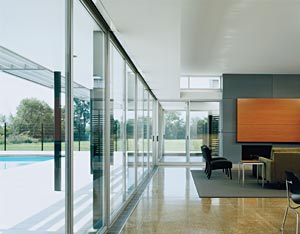 |
Brad Lynch
Brininstool & Lynch
So you have the land. Now you need-and can afford-a knock-’em-dead modern house. Go to Brad Lynch and see if he can fit you in. Lynch designs custom residences and projects for institutions (the new Racine Art Museum, for one), while partner David Brininstool designs larger developments. The firm takes on only two single-family residences a year.
If you commission Brininstool & Lynch (http://www.brininstool-lynch.com/) to design your house, Lynch’s first question will be, "Why?"
"People have a laundry list of what they want to get out of their dream house," he says. That list usually includes a certain number of bedrooms, bathrooms, and other features. But, he says, "We aren’t interested in things that you can point to. We try to get people’s emotions into the house. That’s why we only do two a year."
A home in Peru, Illinois, has a low silhouette composed of modern rectangles, set off by slatted screens that echo corn cribs and other agricultural structures. The award-winning design is immediately impressive, but Lynch points out the more personal touches. "We even considered what time of day they want the kids doing homework," he says. A children’s study/dining booth in the kitchen catches the afternoon sun after school, so the parents can supervise homework while they make dinner.
Lynch is currently designing a suburban house for a family whose daughter is losing her sight. The home is full of different tactile materials to help her enjoy the house and find her way around. She’s an excellent swimmer, and the house will include a pool so that she can invite her friends to visit her. "It’s not an exuberant luxury," says Lynch.
One recent project was a modern house set in a suburban development of McMansions, built with the development’s approved brick and wood, but smaller than its neighbors and oriented toward the woods at the back of the lot. Lynch says the owner’s gratitude grew as he lived in the house. "Months later, he calls me, weeping, on a Saturday morning. He says, ‘I’m standing in the most beautiful home in the world,’" reports Lynch.
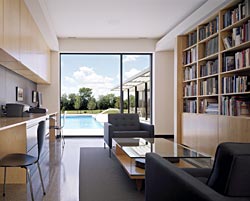 |
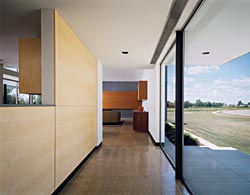 |
| The large windows in the living/dining area of this central Illinois home face south to corral passive solar energy. The home’s L-shape increases privacy by preventing street traffic from seeing into the pool area and yard. The exterior is made of steel wrapped with cement board panels and redwood siding. | |
|
|
|
Friend of the Earth
Live in a way that’s as green as possible
|
Photograph: Katrina Wittkamp |
|
Illustration: Nathan Kipnis
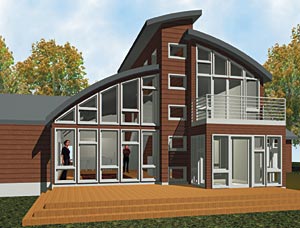 The dramatic shape of this Door County retreat encourages cross ventilation. Large windows face the woods and, just 300 feet away, Lake Michigan. |
Nathan Kipnis
Nathan Kipnis Architects
You want to tread lightly upon the earth, preserving our precious natural resources for future generations. Or you’re hoping to keep your gas bill lower than your mortgage payments. Go to Nathan Kipnis, green architect (www.nkainc.com).
Architects who think sustainable design is important aren’t hard to find. But Kipnis actually went to school for it. His 1985 master’s degree in architecture from Arizona State University has an emphasis in energy-conscious design. But few people wanted green architecture in the 1980s. "I honed my design skills while I waited for demand to grow," says Kipnis.
Now almost everyone who comes to him wants an environmentally sound home. He designs them in two ways. "There’s transparent green, where we can design a ‘normal-looking’ home and make it as green as you can imagine," says Kipnis. "Then there is what I call ‘conspicuous conservation,’ where we show the effort. It’s like the Prius. You’re making your statement."
Kipnis recently renovated an Evanston home owned by two environmental engineering professors. Marrying green design and respect for the landmark home, Kipnis designed south-facing windows with a calculated shade structure that blocks the high summer sun but not the low sun of winter. More conspicuously conservative designs include a passively ventilated lake home in Wisconsin that incorporates the aerodynamic shapes of airplane wings, and a Peoria house that is completely off the grid. Using solar panels, passive solar heating, a wind-powered generator, well water, and a satellite Internet connection, the house has no wires or pipes leading to it.
Sensuous Modernist
Take up residence in a work of art
|
Photography this page:
Steve Hall/Hedrich Blessing 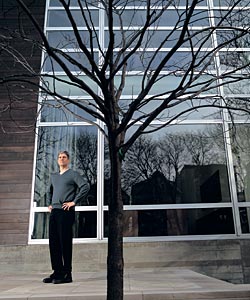 John Ronan
"In a house, you want it to age gracefully and become more interesting over time." |
John Ronan
John Ronan Architect
Clean lines are your thing and you sincerely believe that less is more. But the idea of a steel and glass machine for living chills you to the bone. Go to John Ronan (http://www.jrarch.com/), who warms up modernism by using such unusual materials as board-formed concrete, cedar for interiors, and pre-patinated copper.
Walking into Ronan’s large loft office in River North, where 12 employees work quietly in the single room, a visitor notices a long wall covered in drawings, renderings, and photographs of sleek modern projects. On the floor underneath each representation is a stack of samples of wood, stone, tile, carpeting, glass, rubber-the materials that go, or might go, into each project.
"Our work here is material-oriented. It’s a sensuous modernism," says Ronan. "We keep this stuff around because it’s always informing our work and suggesting possibilities."
His projects often combine organic or rough-hewn textures with the machined, perfect surfaces more typical of modern architecture. When he uses board-formed concrete (poured into wooden molds so that the concrete’s surface has some of the texture of the boards), Ronan uses different woods to create a variegated surface.
For a summer home in Michigan, Ronan is using pre-patinated copper that will turn greener as the house ages, reddish teak that will bear up to rough winters as well as warm up the indoor pool decking, and honey-beige travertine stone.
Pointing to his office’s exposed brick walls, he says, "Look how many colors you see. No two bricks are the same size or shape. You never get tired of looking at it. That’s what we’re trying to create in the houses. In a house, you want it to age gracefully and become more interesting over time."
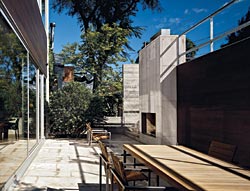 |
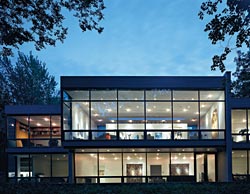 |
|
(Left) This three-story townhouse was designed to maximize light. A glass wall in the kitchen opens to an outdoor courtyard, and a huge skylight helps bring sunlight into the rooms from two different directions. (Right) The two-story glass wall at the back of this house allows views into a forest; the front of the house has less glass. Inside, masonry walls divide the space into eating, sleeping, and relaxing zones. |
|
Man of Conscience
Have a guilt-free vacation house
|
Photo: Wayne Cable, Cable Studios
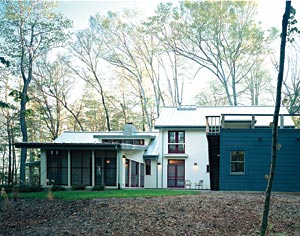 This cottage next to Lake Michigan is C-shaped to allow light to flood interior spaces. |
Peter Landon
Landon Bone Baker Architects
You’ve worked hard. But how can you enjoy your second home when so many people don’t have a first? Go to Peter Landon. At Landon Bone Baker (http://www.landonbonebaker.com/), there are shelves of awards with inscriptions such as "Design Matters: Best Practices in Affordable Housing" and "Rehab Housing for the Homeless." Landon has always been fascinated by multi-unit housing, although growing up in Winnetka, he wasn’t exactly sure what it was. Now his firm is known for its work in subsidized and affordable housing, SROs, and homeless shelters. But he and his colleagues also have made a name for themselves as architects of vacation homes. "Along the way, we started doing summer homes in Michigan," says Landon. "We realized that we could bring the same creativity to both summer homes and affordable housing."
How can summer homes be like affordable housing? "Lifestyles are not that different, which was surprising when we figured it out," Landon says. "People get together and eat, basically, and socialize. And then there are private times. There has to be some separation of space so that people can have privacy, but when you open spaces up, you get more bang for your buck."
Landon’s summer homes are often based on traditional forms but have a contemporary aesthetic. Light-filled lofty spaces are mixed with quirky rooms, such as an office tucked in a bay at the top of a stairway. Landon Bone Baker’s Knothead line of furniture also has crossover appeal. Manufactured from plywood, the affordable, sleekly contemporary pieces-from bunk beds to armoires-work as well in their designs for summer homes as in their homeless shelters for teenage boys.
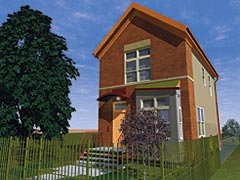 |
Illustrations: Dominik Soltys
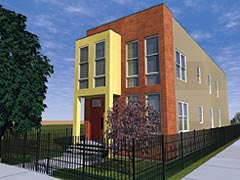 |
|
Landon’s designs for the Home Pride program of the Hispanic Housing Development Corporation, which provides affordable housing in Chicago neighborhoods. |
|
Practical Visionary
Be philosophical in the here and now
|
Photograph: Katrina Wittkamp |
Zoka Zola
Zoka Zola Architecture & Urban Design
You want a house that is a work of art, that expresses an opinion about space, home, privacy, and intimacy. You also want it to accommodate your child, your dog, your office, and your heating budget. Go to Zoka Zola (http://www.zokazola.com/).
Croatian-born Zola studied architecture in Zagreb and worked in London, Rome, and Vienna before coming to Chicago, where she teaches at the School of the Art Institute. Her European art-school vibe manifests itself in a way of talking about her work that is dreamy and visionary, and in finished products that are sleek, practical, and surprisingly American.
Her own house on Chicago’s Near West Side won Architecture Magazine’s Home of the Year Award in 2003. She writes of it, "This house is designed not to feel owned. When the building feels owned it’s impoverished, because it has a flattened relationship with the rest of the world." She lists early 20th-century architects Gunnar Asplund, Ludwig Wittgenstein, and Konstantin Melnikov as her inspiration for the look of the house.
The house feels open and clean, with space flowing from the basement architecture studio, where she works with four employees, through the living areas and up to the private bedrooms and bathrooms on the second floor. Massive windows bring the outdoors in. Her employees use her house’s kitchen, and in summer, meetings are held on the deck off the living room.
"My strength is in organizing space," says Zola. "My projects use space for multiple purposes, and I don’t lock in how the space is used. Someone else can move in and feel that there is room for them and their lifestyle and furniture."
Zola’s questions for a potential client: "Why do you want to commission a house? What do you want out of it? What is your lifestyle? What are your needs?" Then she produces 20 to 30 sketches and asks for feedback. "I get a precise brief from my clients by having them react openly to many possibilities. It allows us to open up and think of every possible solution, without really knowing what the problem is. And the client feels that they have control."
|
Illustration © Zoka Zola |
Solid Citizen
Breathe new life into a classic bungalow
|
Illustration: Scott Sonoc |
Scott Sonoc
Sonoc Architects & Associates
If you live in a bungalow that needs updating, you aren’t alone. The iconic one-and-a-half-story brick houses, some almost a century old, make up about one-third of Chicago’s single-family homes. They are of tremendous historical importance, structurally sound, and often feature beautiful art glass, oak floors, and tile roofs. But many need to be refreshed after decades of wear, or adapted to a modern lifestyle. If yours is one of those, go to the Chicago Historic Bungalow Association and architect Scott Sonoc.
Sonoc doesn’t generally design individual houses. A self-described "social activist with architecture as my tool," he specializes in urban design, and his residential work usually involves master planning for large developments. But helping homeowners preserve their Chicago bungalows became a calling. "There are 80,000 bungalow owners in Chicago, and not enough architects to go around," Sonoc says. "We asked ourselves, ‘How can we help the largest number of people fix up their bungalows on their time frame, with their economic ability?’"
Sonoc and his firm produced eight sets of pattern drawings that can help modernize a bungalow while retaining its historical integrity. Owners can use them to add a deck, enlarge the kitchen, add a bathroom, improve accessibility, improve energy efficiency, expand the second-floor space, add to the back, or rehab the basement. The Chicago Historic Bungalow Association, launched in 2000, has sold more than 1,500 sets of the drawings for $10 each. (Hiring an architect to produce the drawings on an individual basis might cost as much as $5,000.)
The pattern drawings are pre-approved for city permits and include information on how to select and work with a contractor and establish a budget. The Bungalow Association (http://www.chicagobungalow.org/) also offers special loans and grants.




